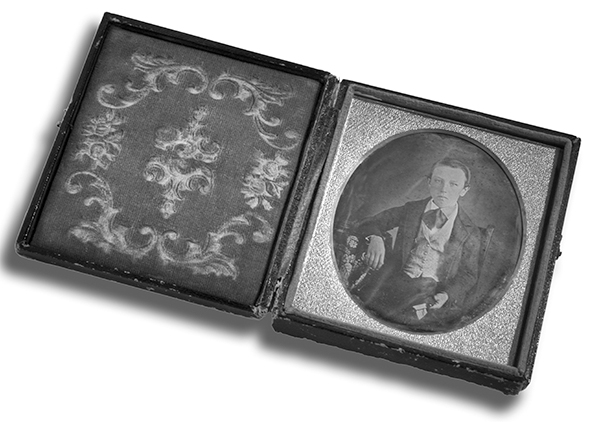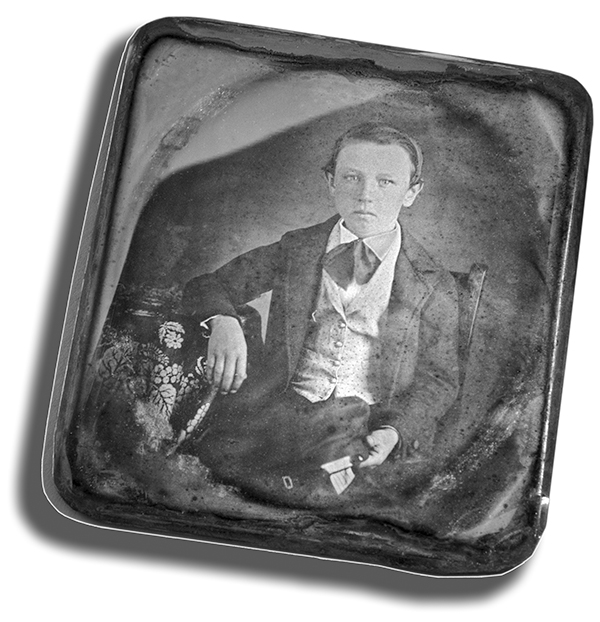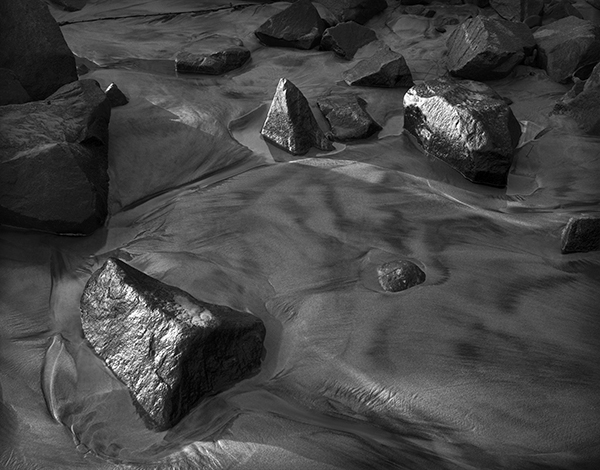Photographer Unknown
American c.1840 – c.1855
[Boy With Hat], 1840 – 1855

Daguerreotype, sixth-plate, 3 1/8" x 2 5/8", Collection of Craig Carlson
I acquired the Daguerreotype of the anonymous boy with hat in 1981, to have an example of early photographic image making to show students. The Daguerreotype was the first successful commercial photographic process. So successful, that after 1840 every city and hamlet had an operating Daguerreotype studio making a fortune, along with a sea of images of its inhabitants.
This Daguerreotype as Daguerreotypes’ go, is not an exceptional specimen. It was purchased by me for five dollars, and cost much more when made in the 1850’s. As a matter of fact, 99.9% of all Daguerreotypes are portraits; nearly an image of a cow, a barn, or due to the sensitivity of the Daguerreotype plate, a moving object. The Daguerreotype studio portrait was a torturous appointment. Metal prongs, obscured by the sitter, jabbed into the neck and behind the ears to hold the subject still during the five minute exposure. The exposed plate was then held over a pool of heated mercury vapors until a whitish alloy settled over the sensitised polished plate.
The case holding a Daguerreotype was designed to cast a shadow over its surface, revealing incredible detail and sharpness, which still rival photographic images made today, two centuries later by electronic means.
 For the above image, I removed the Daguerreotype from its carrying case to examine it closer with a magnifying glass. The young boy appears to be the age of about 14 years. If I calculate the useful commercial span of the Daguerreotype, I would place his birth around c.1841, and the portrait made in c.1854. By the time of the Civil War he would of been of conscription age and I wonder if he fought at Gettysberg, or marched to the sea with Sherman. From the young man’s clothing, and the ability to pay for a Daguerreotype, he must have come from a middle class family of means. Most likely from a hamlet or city north of the Mason-Dixon Line: Cincinnati, Toledo, or from a farm in Wisconsin. His coat and vest look chosen by a tasteful mother, and his cuffs from his shirt and coat sleeves match perfectly at the wrist, giving evidence of a family tailor. If I could, I would telegraph the young soldier to let him know that his nineteenth century Daguerreotype found a permanent home in my collective photographic memory.
For the above image, I removed the Daguerreotype from its carrying case to examine it closer with a magnifying glass. The young boy appears to be the age of about 14 years. If I calculate the useful commercial span of the Daguerreotype, I would place his birth around c.1841, and the portrait made in c.1854. By the time of the Civil War he would of been of conscription age and I wonder if he fought at Gettysberg, or marched to the sea with Sherman. From the young man’s clothing, and the ability to pay for a Daguerreotype, he must have come from a middle class family of means. Most likely from a hamlet or city north of the Mason-Dixon Line: Cincinnati, Toledo, or from a farm in Wisconsin. His coat and vest look chosen by a tasteful mother, and his cuffs from his shirt and coat sleeves match perfectly at the wrist, giving evidence of a family tailor. If I could, I would telegraph the young soldier to let him know that his nineteenth century Daguerreotype found a permanent home in my collective photographic memory.
©Copyright Craig Carlson 2012 All Rights Reserved



 For the above image, I removed the Daguerreotype from its carrying case to examine it closer with a magnifying glass. The young boy appears to be the age of about 14 years. If I calculate the useful commercial span of the Daguerreotype, I would place his birth around c.1841, and the portrait made in c.1854. By the time of the Civil War he would of been of conscription age and I wonder if he fought at Gettysberg, or marched to the sea with Sherman. From the young man’s clothing, and the ability to pay for a Daguerreotype, he must have come from a middle class family of means. Most likely from a hamlet or city north of the Mason-Dixon Line: Cincinnati, Toledo, or from a farm in Wisconsin. His coat and vest look chosen by a tasteful mother, and his cuffs from his shirt and coat sleeves match perfectly at the wrist, giving evidence of a family tailor. If I could, I would telegraph the young soldier to let him know that his nineteenth century Daguerreotype found a permanent home in my collective photographic memory.
For the above image, I removed the Daguerreotype from its carrying case to examine it closer with a magnifying glass. The young boy appears to be the age of about 14 years. If I calculate the useful commercial span of the Daguerreotype, I would place his birth around c.1841, and the portrait made in c.1854. By the time of the Civil War he would of been of conscription age and I wonder if he fought at Gettysberg, or marched to the sea with Sherman. From the young man’s clothing, and the ability to pay for a Daguerreotype, he must have come from a middle class family of means. Most likely from a hamlet or city north of the Mason-Dixon Line: Cincinnati, Toledo, or from a farm in Wisconsin. His coat and vest look chosen by a tasteful mother, and his cuffs from his shirt and coat sleeves match perfectly at the wrist, giving evidence of a family tailor. If I could, I would telegraph the young soldier to let him know that his nineteenth century Daguerreotype found a permanent home in my collective photographic memory.